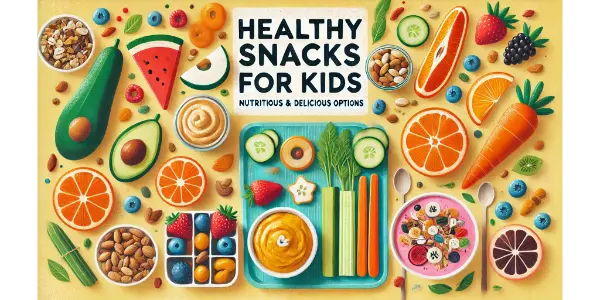Healthy Snacks for Kids: Ever wonder how to keep your kids energetic and focused throughout the day?
The secret lies in healthy, nutritionist-approved snacks! these snacks provide the fuel needed to stay active and sharp.
According to the World Health Organization (WHO), starting healthy dietary practices early, starting from breastfeeding, promotes not only optimal physical growth but also crucial cognitive development in children. [1] [2]
This cognitive development is key to ensuring overall well-being as children mature [3]. The importance of providing quality nutrition to our future leaders can’t be overstated.
This article will cover the benefits of healthy snacks, share delicious options, and offer tips for preparing and serving these research-backed treats. Ready to boost your child’s health? Let’s dive in!

Table of Contents
Benefits of Healthy Snacks For Kids
Nutritional Boost
Healthy snacks provide essential nutrients that support children’s growth and development. Including a variety of food groups in snacks ensures they receive 6 essential nutrients which includes proteins, carbohydrates, fats, vitamins, and minerals necessary for their overall health. [4]
For example, incorporating fruits, vegetables, lean proteins, and whole grains can help children meet their nutritional needs. [5]
Energy and Focus
Healthy snacks help maintain energy levels and improve concentration throughout the day. Balanced snacks prevent overeating during meals and provide steady energy, which is crucial for active children. [4]
Offering snacks that combine proteins, healthy fats, and complex carbohydrates can help sustain energy and focus . [6]
Must Read: Wellhealth Ayurvedic Health Tips
Nutritious Snack Options
Fruits and Vegetables
Fruits and vegetables are excellent snack options. They are rich in vitamins, minerals, and fiber. Some easy-to-prepare options include [7]:
- Apple slices with peanut butter: Combines fruit and protein.
- Carrot sticks with hummus: A crunchy, nutrient-dense snack.
- Fruit salad: A colorful mix of various fruits providing a range of nutrients.
Protein-Rich Snacks
Protein is essential for muscle growth and repair [8]. Examples of protein-packed snacks include:
- Paneer Cubes: Fresh paneer is a great source of protein and calcium. Cut it into cubes for a convenient snack.
- Chana Chaat: Made with boiled chickpeas, this snack is rich in protein and can be spiced up with chopped onions, tomatoes, and a squeeze of lemon.
- Hard-boiled eggs: Easy to prepare and rich in protein.
- Nuts: Provide healthy fats and protein (with consideration for allergies).
- Moong Dal Cheela: These savory pancakes made from moong dal (split green gram) are not only high in protein but also easy to prepare.
Whole Grains
Whole grains provide sustained energy and important nutrients [8]. Recommended options are:
- Multigrain Murukku: A traditional South Indian snack made with a mix of whole grain flours, providing a crunchy and nutritious option.
- Popcorn: A whole grain that can be a fun and healthy snack when prepared with minimal salt and butter.
- Jowar Puffs: Popped sorghum grains seasoned lightly with spices offer a crunchy and healthy snack.
Creative Combinations
Combining different food groups can make snacks more appealing:
- Fruit and Yogurt Parfait: Layer yogurt with mixed fruits and a sprinkle of granola or nuts for a delicious and nutritious treat.
- Roti Rolls: Roll up whole wheat roti with a filling of paneer, vegetables, and a dash of chutney for a flavorful, nutrient-packed snack.
- Peanut Chaat: Mix boiled peanuts with chopped onions, tomatoes, coriander, and a squeeze of lemon for a protein-rich, flavorful snack.
- Masala Corn Salad: Combine boiled corn kernels with chopped veggies, a squeeze of lime, and a sprinkle of chaat masala for a tangy and crunchy snack.
Tips for Preparing and Serving Snacks
Involve Kids in Preparation
Involving children in snack preparation makes the process fun and educational. It encourages them to try new foods and learn about nutrition. [9]
Age-appropriate tasks can include washing fruits, arranging snacks on a plate, or mixing ingredients. [10] [11]
Portion Control
Serving appropriate portion sizes helps prevent overeating. Use small containers or snack-sized bags to manage portions. Teaching children about portion control from an early age fosters healthy eating habits. [12] [13] [14]
Making Snacks Accessible
Keep healthy snacks readily available and within reach for kids. Organize the kitchen or pantry to make healthy choices easy. For example, place fruits and vegetables at eye level in the refrigerator. [15] [16]
Summary
Offering nutritious and delicious snacks is essential for supporting children’s health. By incorporating a variety of food groups and involving kids in the preparation process, parents can encourage healthy eating habits.
Try these snack ideas and consult with a pediatrician or nutritionist for personalized advice to ensure your child’s dietary needs are met.

